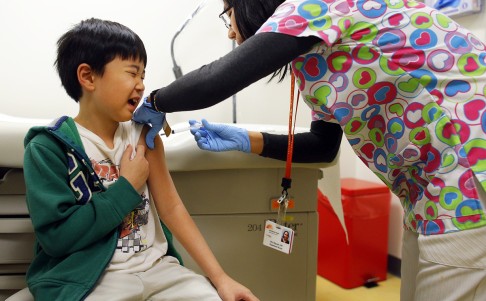
Calling the shots: how the WHO formulates vaccines for flu season

The world’s influenza virus surveillance is a year-round activity done by a global network that involves specialised flu monitoring centres, labouratories and ad hoc groups from more than 100 nations.
The information gathered by this network forms the basis for the WHO’s recommendations for the composition of seasonal influenza vaccines.
The network includes six WHO Collaborating Centres; four WHO Essential Regulatory Laboratories; and 142 institutions in 112 WHO Member States, which are recognised by the UN health body as National Influenza Centres; in addition to ad hoc groups established to address specific emerging issues.
In an interview with the Post, Professor Anne Kelso, director of the WHO Collaborating Centre for Reference and Research on Influenza in Melbourne, explained the process of producing the seasonal influenza vaccine.
Kelso oversees the centre’s virological surveillance for a body that functions as the world’s alert system for possible flu pandemics.
Collecting and analysing flu samples
The vaccine production process begins with the collection of clinical specimens from patients with influenza symptoms by a country’s National Influenza Centre or another national influenza reference labouratory.
The national centres then send these viruses to one of five WHO Collaborating Centres in Melbourne, London, Atlanta in the United States, Beijing and Tokyo.
“So we get a sampling of influenza viruses from patients all over the world,” says Kelso. “The coverage is pretty extensive – we get tens of thousands of viruses each year.”
At the WHO Collaborating Centres, the viruses are taken through a whole series of advanced analyses to characterise the viruses more extensively. The viruses are first cultured so that the scientists have plenty of material to work with.
“We do antigenic analyses: looking at how the viruses relate to previous viruses, how viruses have changed in a way to avoid immunity,” explains Kelso.
“We sequence the genetic material of many viruses so we can look for mutations which might explain any changes in their ability to be recognised by antibodies.
“We also look for antiviral drug resistance and other properties so that we can have a picture of the public health significance of the viruses circulating in many countries in the world,” Kelso said.
World experts weigh in
Multiple telephone conferences are held to conduct preliminary reviews of the available data in the weeks prior to the big meeting at the WHO headquarters in Geneva in February, when the experts discuss the Northern Hemisphere’s seasonal influenza vaccine, and in September, for the Southern Hemisphere’s.
“We share the data and go through them very carefully, and make preparations for the meeting,” says Kelso. “We send viruses to the other labs to do comparisons, so that when we get to Geneva we’d already have a lot of background information on what the other labs have seen.”
In Geneva, experts from the various organisations in the WHO’s global surveillance network carry out a comprehensive consultation of the cumulative data generated by individual labouratories.
“We discuss whether the data suggest that a new variant of any one of those viruses are circulating in the world and causing disease. That’s quite a detailed technical discussion that involves people working in influenza fields to make sound scientific judgments with evidence,” says Kelso.
“It’s very serious discussions and that’s why we meet face-to-face, that’s why we spend three days looking at data, discussing if we think there needs to be a change.”
The big announcement
 |
It’s up to each country to make its own decision whether or not to adopt the WHO recommendations |
On the fourth morning of the meeting, they announce the recommendations formally at a public meeting attended by representatives and individuals from vaccine regulatory agencies, influenza vaccine manufacturers, members of the WHO Global Influenza Surveillance and Response System, and other interested institutions.
The experts write a formal report to explain the data they’ve obtained and to justify the conclusions that we come to.
The report is also published on the WHO website to further communicate the recommendations to health care professionals, influenza vaccine manufacturers and the general public.
If there’s a case for change, the experts will then need to have suitable viruses to provide to vaccine manufacturers.
‘Not binding to every country’
Each country’s national regulatory agencies meet soon after the recommendations are released to decide on the actual virus strains used in their vaccines.
“They are, in the end, just recommendations – it’s not binding on any country,” explains Kelso. “It’s up to each country to make its own decision whether or not to adopt the WHO recommendations.
“The global recommendations are based on global picture, but you could have a part of the world where you have a somewhat different group of viruses circulating.
“So a country may well feel they have a strong case to do something different from the recommendations. Any country can choose to ignore the recommendations, though most of the time countries accept them,” she said.
It will then take a good six months for vaccine manufacturers to produce the vaccine. “A whole lot of work goes into preparing the viruses and then some months to produce enough vaccine for the countries,” says Kelso.
“These six months is the fundamental problem: it means in these six months viruses could mutate and change from the vaccine. That’s exactly what happened with the H3N2 virus of the current flu season.”
Before vaccines are released for sale to the public, they are tested to ensure they have the approved level of hemagglutinin antigen content, or “potency”.
This is the second of a two-part series on the flu outbreak. Click on SCMP Lifestyle for more health stories.